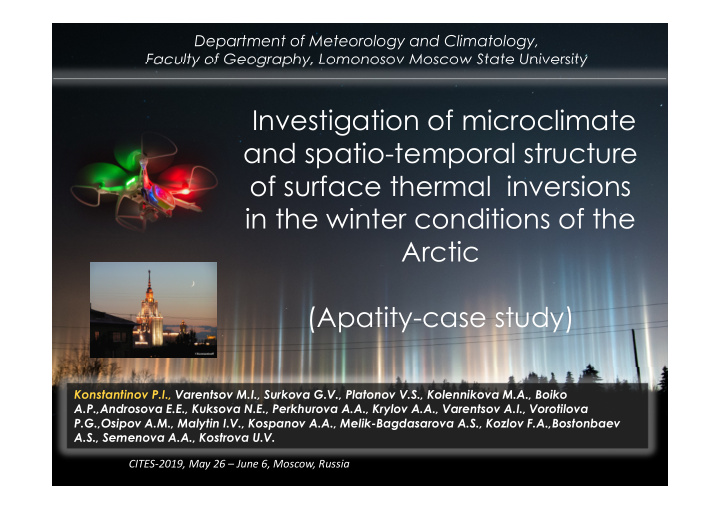



Department of Meteorology and Climatology, Faculty of Geography, Lomonosov Moscow State University Investigation of microclimate and spatio-temporal structure of surface thermal inversions in the winter conditions of the Arctic (Apatity-case study) Konstantinov P.I., Varentsov M.I., Surkova G.V., Platonov V.S., Kolennikova M.A., Boiko A.P.,Androsova E.E., Kuksova N.E., Perkhurova A.A., Krylov A.A., Varentsov A.I., Vorotilova P.G.,Osipov A.M., Malytin I.V., Kospanov A.A., Melik-Bagdasarova A.S., Kozlov F.A.,Bostonbaev A.S., Semenova A.A., Kostrova U.V. CITES-2019, May 26 – June 6, Moscow, Russia
Motivation Boundary layer inversions are closely connected with urban air quality Apatity, Russia Fairbanks, USA
Field measurements WMO station Top-5 Arctic cities: ∆T= 12 ° С 1. Murmansk 295 000 2. Norilsk 179 000 3. Tromso 75 000 4. Vorkuta 58 000 5. Apatity 55 000 Apatity WRF model Observations
Materials and methods Low-cost sensors Traditional AWS Car-based sounding iButton Gradient measurements Dron-based sounding Netatmo-sensors with HOBO
Soundings with different measuring strategies
Spatial differences in thermal profiles Urban core 12 ° C Rural zone Night time 29/01/19
Spatial differences in thermal profiles Urban core Suburban zone 4 ° C Night time 29/01/19
Our poster Our team Thanks for your attention!
Recommend
More recommend